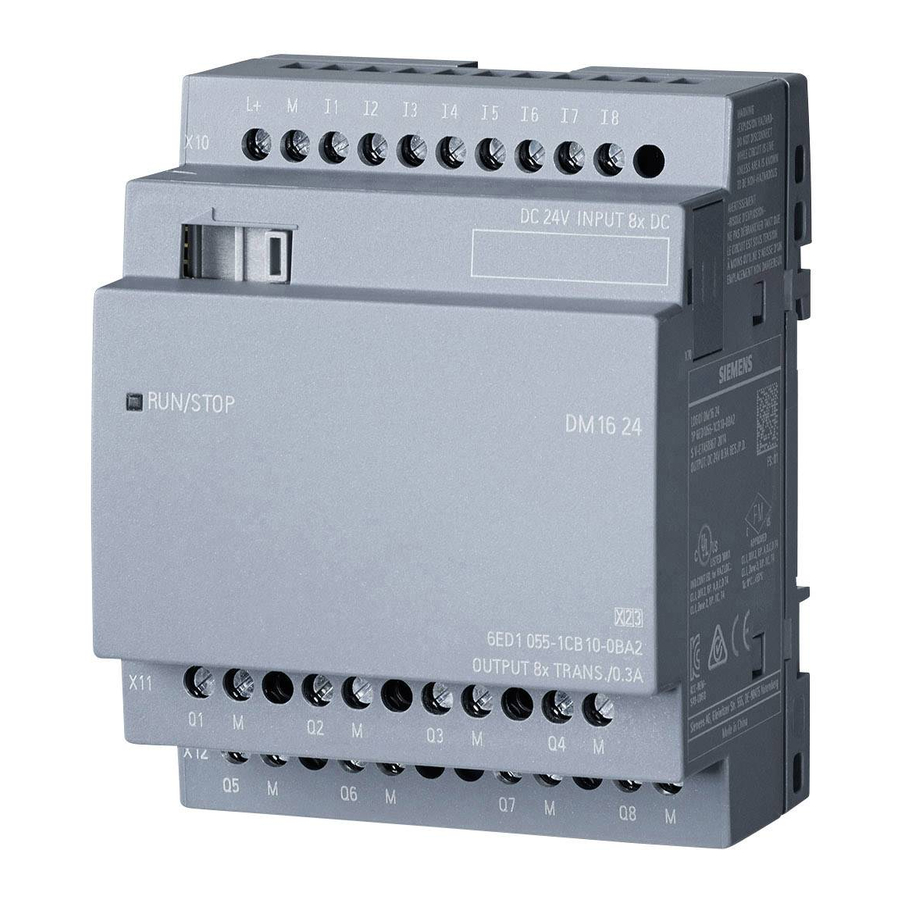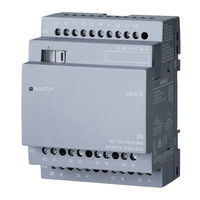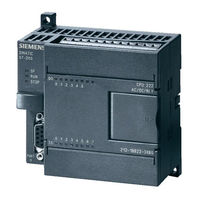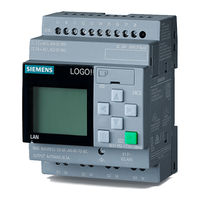
Siemens LOGO! Manuals
Manuals and User Guides for Siemens LOGO!. We have 6 Siemens LOGO! manuals available for free PDF download: Manual, Installation Specification Sheet
Siemens LOGO! Manual (534 pages)
Brand: Siemens
|
Category: Control Unit
|
Size: 28.26 MB
Table of Contents
-
-
Preface3
-
-
Wiring LOGO46
-
-
Connectors70
-
Deleting a Block105
-
Synchronization116
-
-
-
And143
-
NAND (Not AND)145
-
NOR (Not OR)148
-
Time Response151
-
Retentivity153
-
On-Delay160
-
Off-Delay164
-
On-/Off-Delay166
-
Random Generator177
-
Weekly Timer185
-
Yearly Timer190
-
Up/Down Counter201
-
Hours Counter205
-
Analog Amplifier226
-
Latching Relay228
-
Pulse Relay229
-
Message Texts240
-
Softkey243
-
Shift Register245
-
Analog Ramp251
-
PI Controller253
-
-
Parameters290
-
9 LOGO! Software
313 -
10 Applications
317-
Technical Data319
-
-
LOGO! Basic353
-
Logo! Td359
-
D.2 Logo! Td359
-
-
Order Numbers363
-
Abbreviations365
-
Index367
-
-
-
-
-
1 Overview
383-
Product Overview383
-
Product Package394
-
Accessories395
-
-
-
Preparations401
-
-
-
-
-
-
Recycling488
-
-
-
ESD Guideline491
-
Specifications503
-
Power Supply503
-
Power Supply513
-
-
System Events520
-
Abbreviations521
-
Advertisement
Siemens LOGO! Manual (333 pages)
Brand: Siemens
|
Category: Microcontrollers
|
Size: 1.25 MB
Table of Contents
-
Contents1
-
Edition2
-
Guide3
-
-
Risks26
-
Compatiblity30
-
-
Remedy42
-
Restrictions42
-
Logo! am 245
-
-
Connectors63
-
Password87
-
-
Deleting a Block101
-
Synchronization111
-
Weekly Timer115
-
Yearly Timer115
-
Analog Amplifier116
-
Hours Counter116
-
Latching Relay116
-
Message Texts116
-
Pulse Relay116
-
Up/Down Counter116
-
-
Organization119
-
Analog Inputs120
-
Digital Inputs120
-
Digital Outputs120
-
Analog Outputs121
-
Flag Blocks121
-
Cursor Keys122
-
Levels122
-
Startup Flag122
-
And125
-
Nand (Not And)127
-
Nor (Not Or)130
-
-
Logical Inputs133
-
Parameter Inputs134
-
Parameter T134
-
-
Time Response134
-
Retentivity136
-
On-Delay144
-
Off-Delay148
-
On-/Off-Delay150
-
Random Generator161
-
Weekly Timer169
-
Weekday170
-
On-/Off-Times171
-
Cam1172
-
Cam2172
-
Cam3173
-
Yearly Timer174
-
Further Examples176
-
Calculation Rule179
-
Analog Amplifier204
-
Latching Relay206
-
Pulse Relay207
-
Message Text210
-
Factory Setting217
-
Softkey217
-
Shift Register221
-
Analog Ramp228
-
PI Controller233
-
Parameter Sets238
-
Sampling Time238
-
-
-
-
Parameters244
-
-
Compatibility254
-
-
7 LOGO! Software
265-
Updates and Info267
-
-
Applications271
-
A Technical Data275
-
-
Test Program311
-
Setup Menu318
-
Transfer Menu318
-
E Order Numbers319
-
F Abbreviations321
-
Index
323
Siemens LOGO! Manual (292 pages)
Brand: Siemens
|
Category: Microcontrollers
|
Size: 10 MB
Table of Contents
-
Preface3
-
-
Wiring LOGO36
-
-
Connectors58
-
Password76
-
-
-
And108
-
NAND (Not AND)109
-
NOR (Not OR)112
-
Time Response115
-
Retentivity116
-
On-Delay123
-
Off-Delay126
-
On-/Off-Delay127
-
Random Generator135
-
Weekly Timer141
-
Yearly Timer145
-
Up/Down Counter151
-
Hours Counter154
-
Analog Watchdog170
-
Analog Amplifier173
-
Latching Relay175
-
Pulse Relay176
-
Message Texts178
-
Softkey189
-
Shift Register191
-
Analog Ramp197
-
PI Controller201
-
Analog Math209
-
-
Parameters217
-
7 LOGO! Software
237 -
8 Applications
241-
Technical Data245
-
-
LOGO! Basic279
-
Logo! Td283
-
D.2 Logo! Td283
-
-
Order Numbers285
-
Abbreviations287
-
Index289
-
-
Advertisement
Siemens LOGO! Manual (75 pages)
Brand: Siemens
|
Category: Controller
|
Size: 3.57 MB
Table of Contents
-
Plcs5
-
Terminology13
-
Timers52
-
Counters59
-
Final.exam75
Siemens LOGO! Installation Specification Sheet (2 pages)
Brand: Siemens
|
Category: Microcontrollers
|
Size: 0.53 MB
Advertisement





